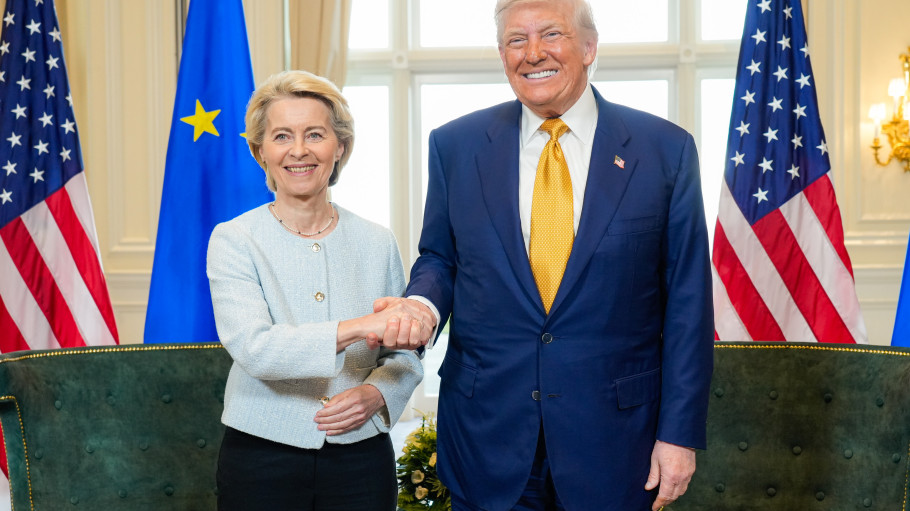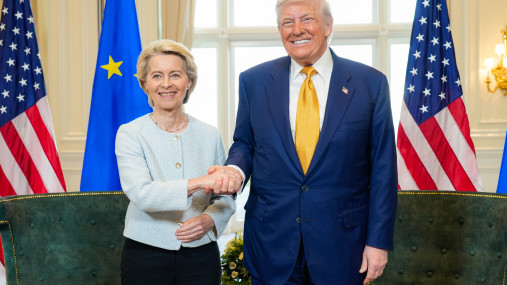
Press releases » EU-U.S. trade deal: in its balancing act, Commission prevented further damage to the EU but for stee
EU-U.S. trade deal: in its balancing act, Commission prevented further damage to the EU but for steel impact remains high as long as 50% tariffs remain in place, says EUROFER
Downloads and links
Recent updates

Brussels, 28 July 2025 – The deal on tariffs struck by the EU with the U.S. limits the damage in the current circumstances, but the impact on European steel remains dramatic as long as 50% tariffs are still applied. A potential joint action EU-U.S. to address global overcapacity and a possible return to a tariff-rate quota system for EU exports to the U.S., as hinted at by Commission President Ursula von der Leyen, are still vague and lack the necessary details to the bring the economic certainty needed by EU steel producers, says the European Steel Association.
“Commission President von der Leyen and trade Commissioner Šefčovič did what they could to prevent further damage to the EU’s economy under the current geopolitical circumstances the EU finds itself in. The impact on EU steel will still be huge, but there are also hopes for a joint EU–U.S. action against the destructive spill-over effects of global steel overcapacity on the EU and U.S. markets”, said Axel Eggert, Director General of the European Steel Association (EUROFER).
Uncertainty remains regarding all the details concerning the European steel industry, which for the time being is still subject to a 50% tariff. Von der Leyen said in her statement after the meeting with U.S. President Donald Trump that “on steel and aluminium, the EU and the U.S. face the common external challenge of global overcapacity. We will work together to ensure fair global competition. And to reduce barriers between us, tariffs will be cut. And a quota system will be put in place”. Answering a journalist’s question about the quotas on steel, asking “What does it mean when the tariffs will be slashed? Does it mean there will be no tariffs even after the quotas?”, von der Leyen replied: “So, it’s basically going back like with the UK to the historical quotas, and creating a ring-fencing to deal with the overcapacity globally that we see”.
“If a zero tariff on our traditional exports to the U.S. is confirmed, we would be going in the right direction. But there is no clarity yet. As always, the devil is in the detail”, stressed Mr. Eggert.
In any case, a 15% tariff on all products means an additional huge burden on steel, as many EU exports are steel intensive, such as machinery and vehicles. In 2024 - back then with a 2.5% tariff - around 760,000 EU vehicles were exported to the U.S. This can be estimated at around 1 million tonnes of EU steel, a significant part of which may disappear as a result of the new 15% tariff. The EU steel industry had already lost around 1 million tonnes of steel exports to the U.S. since the application of U.S. section 232 in 2018, down from 4.6 to 3.8 million tonnes in 2024, of which around 600,000 tonnes had to pay a 25% tariff. A 50% out-of-quota tariff would likely also eliminate those exports.
Since 2018, the European steel industry has lost a staggering 30 million tonnes of steel in the EU internal market and on export markets, due to the effects of global steel overcapacity – driven by countries from Asia, North Africa and the Middle East – as well as the effects of U.S. Section 232, and a decrease in steel demand in EU steel using sectors. The effects of the latest additional U.S. tariffs on EU steel applied since March (25%) and June (50%) are already having a further destructive impact on the sector. The European Commission promised in its Steel and Metals Action Plan a “highly effective steel trade measure” to be presented by September 2025.
“EU steelmakers cannot wait any longer and trust that this new measure will be highly effective as envisaged by the Steel and Metals Action Plan, allowing EU steel capacity utilisation at around 85%, aligned with the U.S., to secure the EU’s economic resilience and strategic autonomy”, concluded Mr. Eggert.
Photo source: EC - Audiovisual Service - © European Union, 2025
Contact
Lucia Sali, Spokesperson and Head of Communications, +32 2 738 79 35, (l.sali@eurofer.eu)
About the European Steel Association (EUROFER)
EUROFER AISBL is located in Brussels and was founded in 1976. It represents the entirety of steel production in the European Union. EUROFER members are steel companies and national steel federations throughout the EU. The major steel companies and national steel federation of Turkey, Ukraine and the United Kingdom are associate members.
The European Steel Association is recorded in the EU transparency register: 93038071152-83.
About the European steel industry
The European steel industry is a world leader in innovation and environmental sustainability. It has a turnover of around €215 billion and directly employs around 298,000 highly-skilled people, producing on average 146 million tonnes of steel per year. More than 500 steel production sites across 22 EU Member States provide direct and indirect employment to millions more European citizens. Closely integrated with Europe’s manufacturing and construction industries, steel is the backbone for development, growth and employment in Europe.
Steel is the most versatile industrial material in the world. The thousands of different grades and types of steel developed by the industry make the modern world possible. Steel is 100% recyclable and therefore is a fundamental part of the circular economy. As a basic engineering material, steel is also an essential factor in the development and deployment of innovative, CO2-mitigating technologies, improving resource efficiency and fostering sustainable development in Europe.

A milestone occasion to quickly and effectively restore affordable electricity, to relaunch the
decarbonization and strengthen the international competitiveness of the European steel
industry.
Brussels, 02 December 2025 – Unchanged negative conditions – U.S. tariffs and trade disruptions, economic and geopolitical tensions, protracted weak demand and still high energy prices – continue to weigh on the European steel market. EUROFER’s latest Economic and Steel Market Outlook confirms for 2025 another recession in both apparent steel consumption (-0.2%, unchanged) and steel-using sectors (-0.5%, revised from -0.7%). A potential recovery is expected only in 2026 for the Steel Weighted Industrial Production index (SWIP) (+1.8%, stable) and for apparent steel consumption (+3%, slightly revised from +3.1%) – although consumption volumes would still remain well below pre-pandemic levels. Steel imports retained historically high shares (27%), while exports plummeted (-9%) in the first eight months of 2025.
Fourth quarter 2025 report. Data up to, and including, second quarter 2025